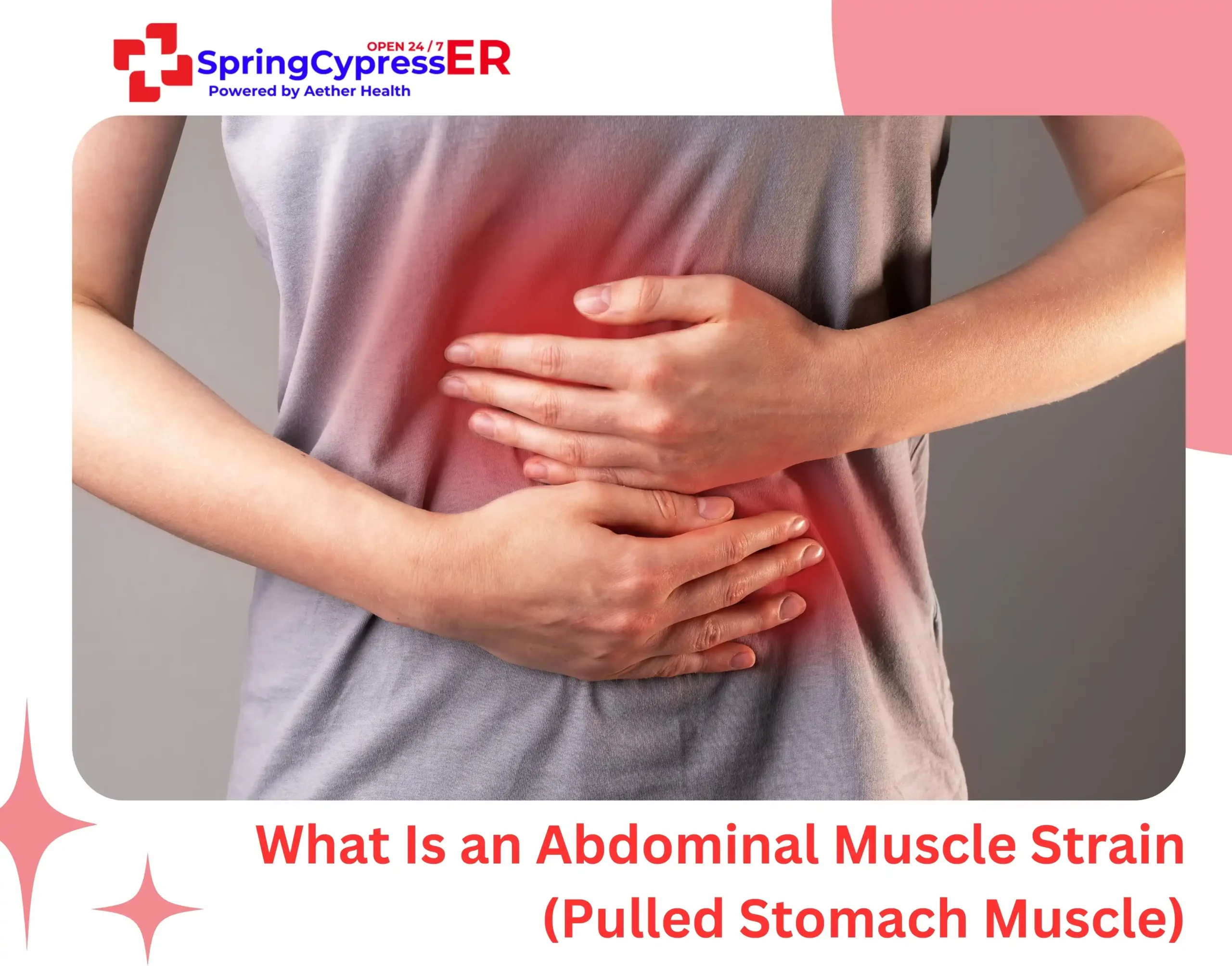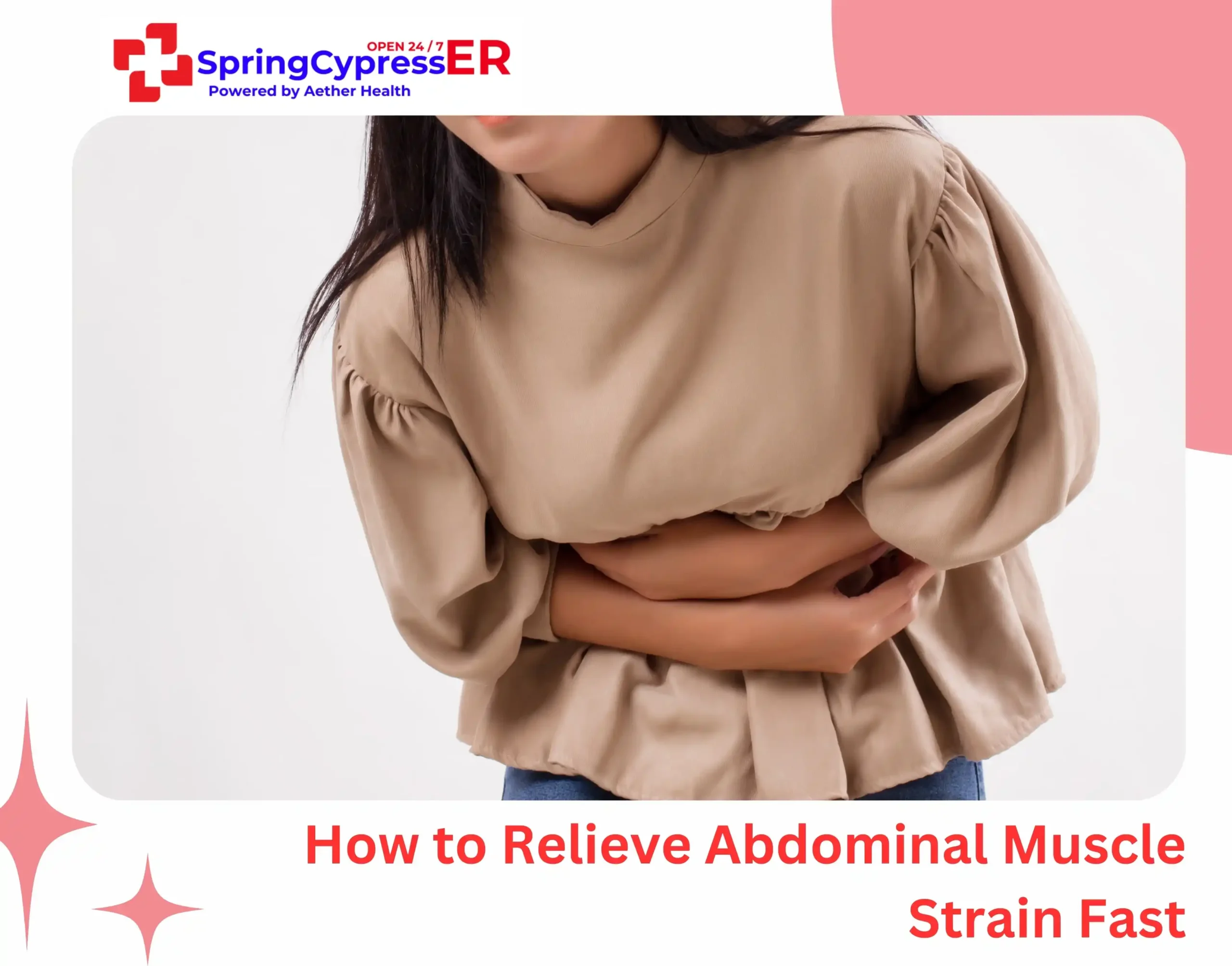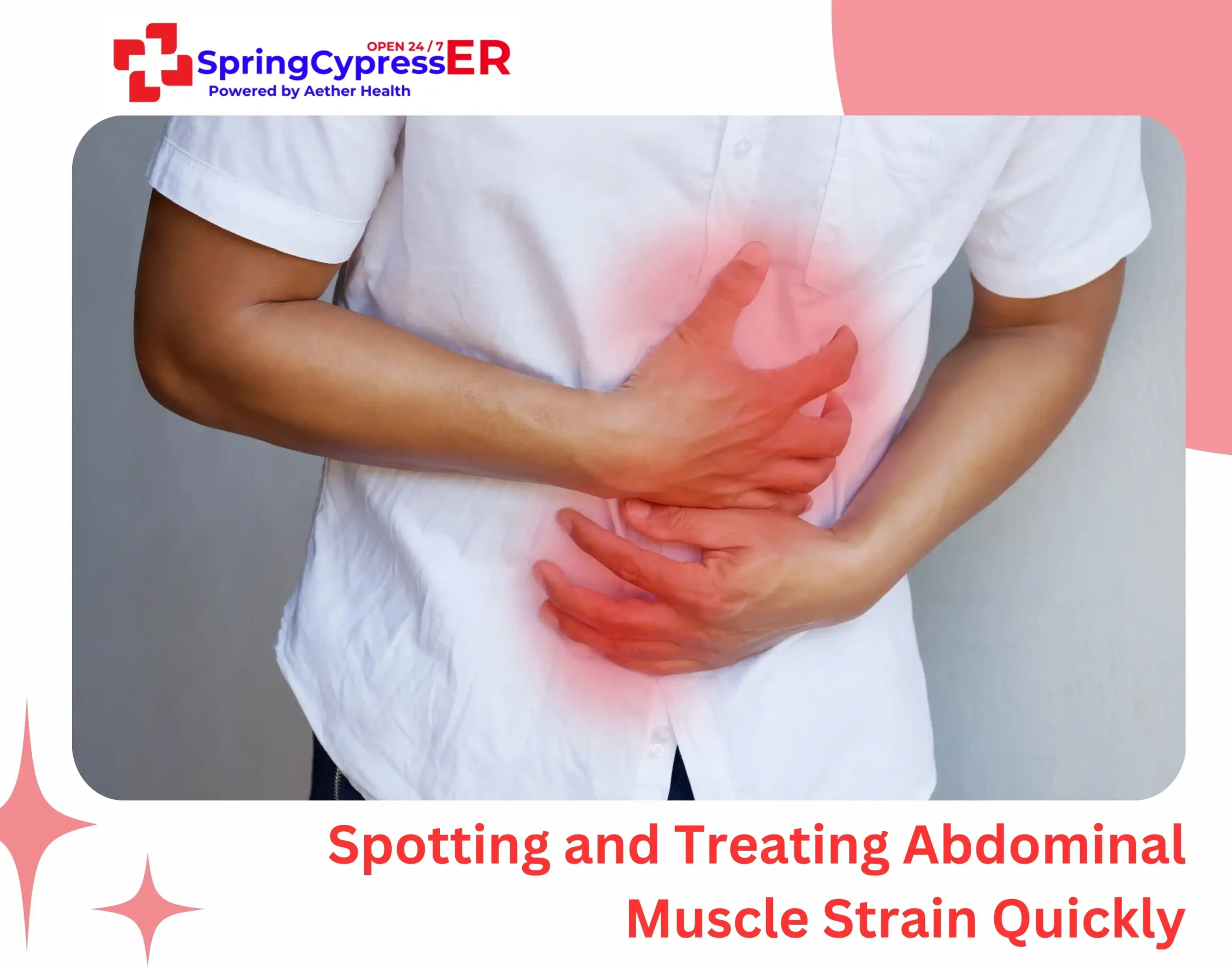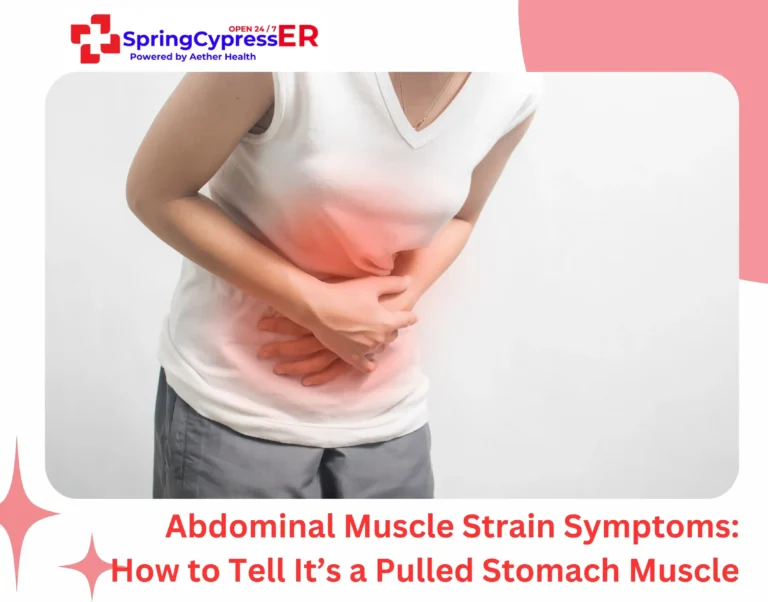An abdominal muscle strain often gets mistaken for digestive issues, hernias, or gynecological problems because the symptoms overlap. The real difference lies in when and how the pain occurs.
Abdominal muscle strain symptoms include sharp pain with movement, muscle spasms, tenderness to touch, and visible swelling. You’ll also experience difficulty with coughing, laughing, or lifting due to core muscle weakness.
Let’s explore these specific symptoms so you can avoid weeks of ineffective treatments and accelerate your recovery.
What Is an Abdominal Muscle Strain (Pulled Stomach Muscle)?

An abdominal muscle strain, often called a pulled stomach muscle, occurs when your abdominal wall fibers tear or stretch beyond their limit. This happens during activities like heavy lifting with poor form, sudden twisting movements, or intense core exercises.
The abdominal wall consists of several muscle groups working as a natural corset.
- The rectus abdominis creates your “six-pack” and helps you bend forward.
- The external and internal obliques wrap around your sides, allowing rotation and side-bending.
- The transverse abdominis acts as your deepest stabilizer, compressing your organs and supporting your spine.
When these stomach muscles strain, microscopic tears create inflammation, pain, and protective muscle spasms that limit your movement.
Where Do Abdominal Muscle Strains Occur?
When you understand which area of your abdomen hurts, you can better identify what happened and what to expect during recovery:
● Upper Abdominal Muscle Strain
Upper abdominal muscle strain usually affects the rectus abdominis just below the ribcage. It often happens after intense ab workouts, sudden forward bending, or heavy lifting without core support. The pain worsens when you sit up from lying down, cough, sneeze, or laugh.
● Lower Abdominal Muscle Strain
Lower abdominal strain is commonly caused by leg-raising exercises, improper lifting techniques, or repetitive twisting motions. The strain injures the rectus abdominis muscle below the belly button. You’ll feel sharp pain when climbing stairs, lifting your legs, or getting out of bed.
● Left Side Abdominal Muscle Strain
A pulled muscle strain on the left side usually involves the left oblique muscles along your ribs and waist. Causes often include rotational sports such as tennis, golf, or baseball. Pain flares when you bend or twist to the right side.
● Right Side Abdominal Muscle Strain
A pulled stomach muscle on the right side usually occurs due to repetitive trunk rotation or sudden direction changes. You’ll feel sharp pain along the right side of your waist and ribs, especially during leftward bending or twisting.
● Deep Abdominal Muscle Strain
Deep abdominal strain affects the transverse abdominis, creating a constant ache across your entire midsection. This strain causes core instability, making basic movements like walking or standing feel unsteady.
Keep in mind: Professional evaluation remains essential, as hernias, appendicitis, and gynecological conditions can mimic these lower abdominal pain patterns.
Primary Abdominal Muscle Strain Symptoms
The most common symptoms of abdominal strain include:
- Sharp or Stabbing Pain: Abdominal strain manifests as a sudden, sharp pain that feels like a tearing sensation. The pain strikes at the moment of injury and lingers as a dull stomach ache that worsens with movement.
- Muscle Spasms: Involuntary tightening or twitching of the abdominal muscles is common. These spasms may occur spontaneously or when attempting to move, often triggered by sudden bending or lifting children or household items.
- Tenderness to Touch: The injured area becomes sensitive, and even light pressure can cause discomfort. This tenderness helps distinguish a pulled stomach muscle from deeper abdominal conditions.
- Swelling and Bruising: Visible swelling around the injury site is one of the most visible pulled stomach muscle symptoms. The swelling is often accompanied by bruising that appears within 24-48 hours of the initial abdominal strain.
- Difficulty with Movement: Simple activities like coughing, sneezing, laughing, or changing positions become painful. Walking, sitting up, or getting out of bed may feel restricted when experiencing a pulled stomach muscle.
Secondary Symptoms of Abdominal Strain
Beyond the primary pulled stomach muscle symptoms, you may experience secondary effects, such as:
- Reduced Range of Motion: You may find it difficult to bend, twist, or move without pain. This limitation can disrupt daily tasks.
- Weakness in Core Muscles: The injured muscle may feel weak or unable to contract properly, affecting overall core stability and strength. This weakness in core muscles can last weeks after the initial abdominal strain.
- Referred Pain: The pain from abdominal strain can radiate to other areas, including the lower back, hips, or groin region.
- Sleep Disruption: Pain often worsens at night, making it difficult to find a comfortable sleeping position and causing fatigue during recovery.
Causes of Abdominal Muscle Pain in Women
Abdominal muscle strain in women can occur due to pregnancy-related changes, hormonal fluctuations, exercise habits, and prior injuries. These factors make women more vulnerable to pulled stomach muscle symptoms compared to men:
- Pregnancy-Related Changes: During and after pregnancy, the abdominal wall stretches, and the rectus abdominis may separate (diastasis recti). This makes women more likely to experience abdominal strain when returning to exercise. Post-pregnancy abdominal pain and weakness are especially common.
- Hormonal Fluctuations: Hormones like relaxin, which rises during menstruation and pregnancy, can affect ligament and muscle stability, potentially increasing the risk of stomach muscle pain in women.
- Exercise Patterns: Activities that involve sudden twisting, heavy lifting, or intense core work can trigger core injury symptoms if done with poor form or rapid progression.
- Previous Injuries: Scar tissues from prior abdominal surgeries or injuries can reduce muscle flexibility and increase the risk of future abdominal strains and recurring pulled stomach muscle symptoms.
Strengthening core muscles, practicing good lifting techniques, and easing back into exercise after pregnancy can reduce these risks for women.
Grades of Abdominal Strain
Doctors classify abdominal muscle strain into three grades based on severity and pain level. Each grade presents different pulled stomach muscle symptoms and recovery needs:
- Grade 1 (Mild): Minimal muscle fiber damage with mild pain and little functional limitation. Grade 1 pulled stomach muscle symptoms may include slight discomfort during movement and minimal swelling. Muscle pain at this level is manageable with conservative treatment.
- Grade 2 (Moderate): Partial muscle tear with moderate to severe pain, noticeable swelling, and significant functional impairment. Grade 2 injury symptoms typically require several weeks of recovery and may need professional intervention to address the abdominal strain properly.
- Grade 3 (Severe): Complete muscle rupture with severe pain, extensive swelling, possible visible deformity, and major functional loss. Severe abdominal strains require immediate medical attention and comprehensive treatment.
When to See a Doctor for Pulled Stomach Muscle
See a doctor immediately if you experience:
- Severe abdominal pain that doesn’t improve with rest or pain medication
- Visible bulging or hard lump that doesn’t reduce when lying down (possible hernia)
- Fever above 101°F with abdominal pain
- Nausea, vomiting, or inability to keep fluids down
- Blood in vomit or stool
- Abdominal rigidity (stomach feels board-like when touched)
- Inability to walk or stand due to severe pain
Schedule Doctor Appointment Within 24-48 Hours For:
- Muscle pain persisting longer than one week without improvement
- Gradual worsening of symptoms despite rest
- Numbness or tingling in the abdominal area
- Recurrent strains in the same location
- Pain interfering with sleep or daily activities
Most abdominal muscle strains heal with conservative treatment, but these warning signs indicate potential complications requiring professional evaluation.
How to Relieve Abdominal Muscle Strain Fast

Fast relief for mild abdominal muscle strain involves rest, targeted care, and gradual return to activity.
- Rest and Ice: Apply ice wrapped in a thin towel for 15-20 minutes to reduce pain and swelling. Lie down with knees bent toward your chest to relax abdominal muscles. Take slow, controlled breaths to avoid engaging strained core muscles.
- Gentle Compression and Support: Use an elastic wrap or compression garment around your midsection to reduce muscle spasms and provide stability during movement.
- Pain Relief: Consider over-the-counter medication like ibuprofen or naproxen to reduce pain and inflammation, or consult your healthcare provider for guidance.
- Activity Modification: Avoid bending at the waist, heavy lifting, and twisting movements that can worsen the strain. Gradually return to normal activities as pain decreases.
- Heat Therapy and Gentle Stretching: After initial swelling subsides (typically 48 hours), switch to warm compresses to increase blood flow and promote healing. Begin gentle stretches like knee-to-chest movements while lying down.
- Recovery: Mild strains typically improve within 1-2 weeks, while moderate strains may require 4-6 weeks. Seek medical evaluation if pain worsens with rest, or if you experience fever, persistent nausea, or visible bulging.
Abdominal Muscle Strain vs. Other Core Injuries
Several serious conditions create nearly identical abdominal strain symptoms, leading to delayed treatment and worsened outcomes. Here’s how to distinguish between them:
- Abdominal Muscle Strain vs Hernia
Hernias create visible bulges that often reduce when lying down, while muscle strains cause diffuse tenderness without lumps. Hernias typically worsen with coughing or straining, but the bulge remains constant. Muscle strains improve with rest and worsen primarily with movement.
- Abdominal Muscle Strain vs Digestive Issues
Irritable bowel syndrome and gastritis cause cramping pain that relates to eating, bowel movements, or stress. Muscle strain pain stays constant and worsens specifically with physical movement like bending or twisting, not digestion.
- Abdominal Muscle Strain vs Gynecological Problems
Ovarian cysts and endometriosis often cause deep pelvic pain that correlates with menstrual cycles. Muscle strain pain occurs in the abdominal wall (closer to the surface) and connects directly to the movement or activity that caused the injury.
- Abdominal Muscle Strain vs Appendicitis
Appendicitis starts near the belly button then moves to the lower right abdomen, accompanied by nausea, fever, and worsening pain. Muscle strain pain, on the other hand, stays localized to the injured area and improves with rest.
How to Prevent Abdominal Muscle Strain
Most abdominal muscle strains happen because of preventable factors like poor body mechanics, inadequate warm-up, or core weakness. Building proper movement patterns and maintaining muscle balance can significantly reduce your injury risk.
- Proper Warm-Up Techniques: Spend 5-10 minutes on light cardio before core exercises. Perform gentle torso twists, arm circles, and knee lifts to activate abdominal muscles gradually. Never jump into intense ab workouts or heavy lifting without preparing your muscles first.
- Core Strengthening Exercises: Build core stability with planks, dead bugs, and bird dog exercises rather than just traditional crunches. Focus on proper form over repetitions. Strengthen all core muscle groups, not just the visible “six-pack” muscles.
- Safe Lifting Mechanics: Bend at your knees and hips, not your waist, when picking up objects. Hold items close to your body and avoid twisting while lifting. Engage your core muscles before lifting by gently pulling your belly button toward your spine.
- Posture and Daily Movement: Maintain neutral spine alignment whether sitting, standing, or walking. When coughing or sneezing, support your abdomen with your hands to reduce sudden muscle stress. Take frequent breaks from prolonged sitting to prevent core muscle stiffness.
- Progressive Activity Return: Gradually increase exercise intensity over several weeks, especially after pregnancy, illness, or periods of inactivity. Start with basic movements before advancing to complex exercises. Listen to your body and don’t push through early warning signs of muscle strain.
- Address Muscle Imbalances: Strengthen weak hip flexors and glutes that can overburden abdominal muscles. Include flexibility work for tight areas like hip flexors and lower back. Consider professional assessment if you experience recurring strains in the same area.
Spotting and Treating Abdominal Muscle Strain Quickly

Abdominal muscle strain symptoms like sharp pain with movement, muscle spasms, and tenderness typically improve with rest, ice, and proper care. Most mild strains heal within one to two weeks when treated correctly.
Seek immediate medical attention if you experience severe abdominal pain, visible bulging, fever, or symptoms that worsen despite rest. These signs may indicate complications requiring professional treatment.
The Spring Cypress emergency room provides 24/7 care for abdominal strain and stomach muscle injuries. We conduct on-site imaging and advanced lab work to pinpoint the exact cause of your injury and begin appropriate treatment. With no surprise billing, you can focus on recovery without financial stress.
FAQs
1. What does a pulled muscle in your stomach feel like?
A pulled stomach muscle often feels like a sharp or stabbing pain at the time of injury, often described as a tearing sensation. The pain worsens with movement, coughing, or laughing.
2. What can be mistaken for a pulled stomach muscle?
Conditions such as ovarian cysts, endometriosis, hernias, or digestive issues like gastritis and IBS are often mistaken for a pulled stomach muscle. Seek professional evaluation to rule out serious conditions.
3. How do I know if stomach pain is muscular?
If the pain worsens when you bend, twist, cough, or press on the area and improves with rest, it’s more likely to be abdominal strain rather than an internal issue.
4. Does a pulled muscle hurt to touch?
Yes, tenderness is a key pulled stomach muscle symptom. Even light pressure on the affected area can cause noticeable discomfort.
5. What helps a pulled stomach muscle female?
Rest, gentle activity modification, ice in the first 48–72 hours, followed by heat, and gradual core strengthening are the best approaches. Professional care may be needed if pain persists.
6. How long does a pulled stomach muscle take to heal?
Recovery depends on severity of the strain. Mild strains may heal in 1–2 weeks, moderate injuries can take 4–6 weeks, while severe abdominal strains may require several months and medical care.




